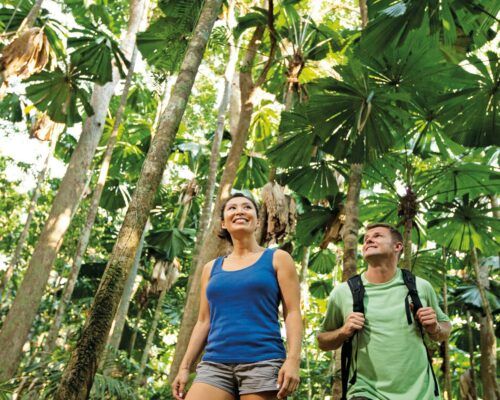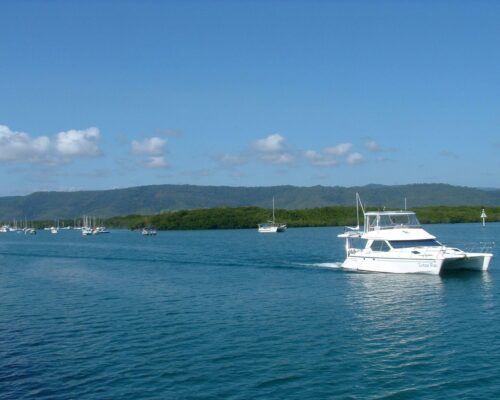The Daintree River valley is surrounded by the vast World Heritage Listed rainforest wilderness. It is fed by the tropical monsoonal rains, the volumes of which produce a strong course of freshwater from the upper region through to the saltwater at the mouth of the river where it flows out to the Coral Sea and Great Barrier Reef at high tide. The Daintree River spans 140 kilometres and its catchment covers an area of 2192km2, it is one of the longest rivers on the East Coast of Australia. Best known for its exceptional bird watching sites, barramundi fishing and crocodile spotting, the Daintree River is a captivating ancient waterway with a huge diversity of species.
From your Port Douglas accommodation, the Newport on Macrossan, to the Daintree River it is 50kms approximately forty five minutes drive.
For nature lovers to truly see and understand the Daintree River’s complex ecosystems and wildlife a river tour is essential.
Daintree Discovery Tours incorporate a Daintree River cruise as part of their full day tour of the Daintree and Cape Tribulation.
Tony’s Tropical Tours also include a Daintree Wildlife cruise on their full day tour to Cape Tribulation and Bloomfield Falls.
Alternatively for those choosing to self drive, Bruce Belchers Daintree River Cruises have been operating for 21 years, Bruce offers a personal and very informative one hour cruise.
Highlights of the Daintree River:
• Crocodile Spotting
• Bird watching
• Snake sightings
• Frog and rare insects
• Fishing
• Daintree River Ferry
• Beautiful scenic backdrop
• Diverse Eco system
• 31 mangrove species
The Daintree River was first discovered by the European explorer Dalrymple in 1873, who was so taken by its ample natural beauty, that he wrote the Daintree has “the finest river scenery in the Colony”.
Unfortunately for the Kuku Yulanji people who lived in harmony along the banks of the river, the explorer also wrote of the plentiful red cedar. With timber in heavy demand, the impact of the explorer’s report was immediate and within months, the easily accessible timber was being exploited. Once the immense quantities of the large stands of cedar were felled the land was opened up for selection to other European settlers.
However the Daintree River is prone to flooding, and in 1895 there was a devastating flood, the first one to seriously affect the recently arrived European settlers. By contrast, the traditional owners (Kuku Yulanji) have been estimated to have camped on the banks of the Daintree River for around 9000 years. The quick rise of the river level is of no surprise to them and their nomadic lifestyle is so in tune with nature that it is well suited to accommodating dramatic changes in weather conditions.
The short “early settler’s” history of the Daintree River is a chronicle of the fluctuating fortunes of the timber, grazing and sugar industries. By contrast today, the Daintree River is a significant tourist attraction and revered waterway.
Considered to be one of the best bird watching sites in Australia, the Daintree River attracts many rare species, including some of the world’s smallest parrots and kingfishers to some of the largest of cuckoos. Throughout the year, over half of Australia’s bird species can be seen along the Daintree River and in the summer months, the migratory waders from the Northern Hemisphere can be found at the mouth of the Daintree. Bird watching enthusiasts are encouraged to take one of the specialist early morning river tours for maximum sightings.
Another popular activity on the Daintree River is crocodile spotting. There is immense interest in Australia’s largest reptile, and the Daintree River is home to over 70 adult saltwater crocodiles. Whilst the crocodiles are seen on most trips, the best times are at low tide when they can be easily found regulating their temperature on the sunny banks of the river. Visitors are encouraged to enjoy these remarkable predators in their natural environment and from the safety of a tour boat. Under no circumstances should you feed the crocodiles or swim in the river.
Some of the unique eco system of the Daintree River can be attributed to the mangrove tree, which uses its distinctive root system to breathe. There are 31 different mangrove species that thrive in the Daintree River system and their desalinating leaves are the start of a complex food chain that eventually nourishes the Great Barrier Reef.
Superbly sheltered the Daintree River is renowned by locals for the excellent recreational fishing on offer. With an abundance of species including the large Queensland mud crab, Mangrove Jack, Queen Fish, Golden Trevally and of course the most prized Barramundi.
Whether you want to fish, bird watch or croc spot the majestic Daintree River is a must and whilst you’re there you don’t want to miss the Daintree River Ferry. The only way to the other side of the Daintree is via the cable car ferry – a real novelty the first time.








